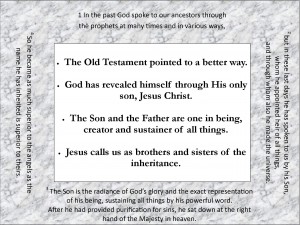THE BIG PICTURE
 Have you ever made a jigsaw puzzle? When you first start out, you’re wondering how in the world all of these pieces will fit together to look like the picture on the box. And be honest, don’t you secretly worry until you place the last piece that one might be missing, that somehow someone left out the last piece or someone lost it? As you come down to the finale placements, you’re trying to visualize just how the last ones fit together, to see if the picture before you will actually match the one advertised. Do you find yourself distracted as your attention drifts from the task at hand? Maybe a piece doesn’t fit just as you thought it would, or a piece that you were sure would fit in the corner suddenly proves to be vital for another area of the puzzle.
Have you ever made a jigsaw puzzle? When you first start out, you’re wondering how in the world all of these pieces will fit together to look like the picture on the box. And be honest, don’t you secretly worry until you place the last piece that one might be missing, that somehow someone left out the last piece or someone lost it? As you come down to the finale placements, you’re trying to visualize just how the last ones fit together, to see if the picture before you will actually match the one advertised. Do you find yourself distracted as your attention drifts from the task at hand? Maybe a piece doesn’t fit just as you thought it would, or a piece that you were sure would fit in the corner suddenly proves to be vital for another area of the puzzle.
The author of Hebrews finds himself in the same predicament, only the stakes are a whole lot higher. You can walk away from a jigsaw puzzle that is only half-complete and maybe you’re out $5.95, but what is the cost of ignoring the salvation presented by Jesus?
2 For since the message spoken through angels was binding, and every violation and disobedience received its just punishment, 3 how shall we escape if we ignore so great a salvation?
Hebrews 2:2
Though scholars debate on who the target audience was, there is little disagreement as to the purpose of the book. A group who has been taught the Gospel as handed down through the disciples is beginning to question their original understanding. Maybe they did not experience what they expected, or Christ did not return as quickly as they had understood He would. Perhaps they are inclined to go back to the established norms in which they were raised. Whatever the cause, the author harkens them back to their previous beliefs through the Old Testament and illustrates how their old ways pointed to the new. He takes the Scripture and uses it differently, in the same context but with a different application. He points them back to Christ crucified, raised from the dead and ascended to the right hand of the Father. Our salvation has come. So what does the world look like through that lens?
In the middle of the lens are the points that the author develops as he exhorts and encourages his audience to live life in accordance with a new covenant. But the statements are just arrows directing us on a path. Sometimes thepath is well-worn and clear, while at other times, the path is overgrown, and it may feel as if we are guessing about our best possible course, just like in the jigsaw puzzle. I love to fit the pieces when I have a clearly-defined picture of something like a boat or a house, but give me azure blue sky pieces without clouds or other defining features, and my interest could easily begin to drift away.
So what are the pieces of your life that do not seem to be fitting? What frustrations are you harboring that seem to be insurmountable? Do not let the situations or individual pieces of the puzzle divert your attention from the bigger picture.
Each piece of the puzzle has its place, each vital to the complete picture. And just as all of the pieces interlock, our situations and lives form a picture.
Join us Sunday as Rt. Reverend Brighton Vita Malasa visits from Upper Shire Diocese Malawi, and take time to review the puzzle with him. How does the international communion connect with the local? How do we serve one another so that the puzzle is God’s vision and not one that we have painted over because the pieces did not seem to fit? How does a different perspective or vantage point clarify our understanding of the big picture and change our use of the individual puzzle pieces we have been given?

